Blog » How to Guides » GROW Model Of Coaching
GROW Model of Coaching
The GROW Model has, time and again, proven its effectiveness; it is great at driving specific results that lead to major breakthroughs.
So if you want to:
1. Learn the four stages of using it
2. Guide your clients through finding obstacles, setting goals and finding solutions
3. Learn how the model can complement your practice
Then read on to find out how you and your clients can specifically use the GROW model in your favor.
Let’s get started!
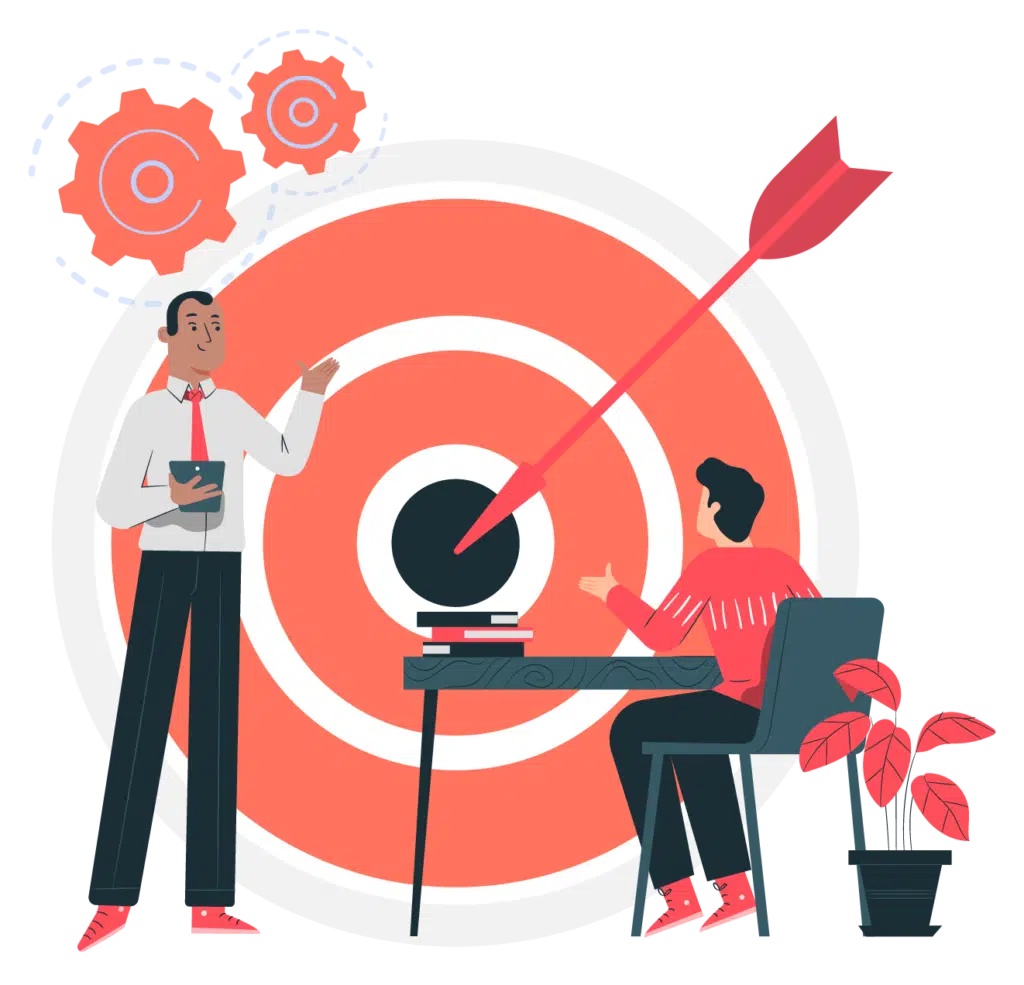
Don’t have time to read the whole guide right now?

No worries. Let me send you a copy so you can read it when it’s convenient for you. Just let me know where to send it (takes 5 seconds)
Yes! Give me my PDFStep 1:
The Basics
There is an immense saturation of various training models in the world of coaching.
Some are fit for specific purposes, while others are for more general growth options.
However, if there is one model that you should use, and recommend to your coaching clients, it is the GROW model.

What is the GROW model?
The first question you might have is, possibly, What exactly is the GROW model?
The answer is quite simple – GROW is an acronym for:
Goals that you want to achieve
Reality that you need to assess and understand to make an informed decision
Options, and the obstacles that you need to consider while making that decision
Will (or way forward) to make the plan pan out in reality. From the looks of it, the GROW model seems really straightforward, and in fact, it is. This is the reason why it is so popular and helpful for a range of coaching styles and clients.
How is it beneficial?
Our team discovered that, unlike other models, which have been much-debated, the GROW model has been extensively used since the 1980s in corporate as well as other types of coaching.
Based on my first-hand experience, here are the benefits of the GROW Model of Coaching:
1. Its Simplicity
The first and foremost benefit of the GROW model is that it is the simplest method for goal-setting and problem-solving.
It allows any user to apply a great deal of skill and knowledge to each stage of the process according to their needs.
2. Proven Track Record
Through our practical knowledge, it has a proven track record simply because it is easy and simple to execute.
3. Value Add Vis-A-Vis Time
Adding the GROW coaching method to your sessions will yield results unparalleled by any other model without being very time-consuming.
4. Concise And Flexible
It is also extremely beneficial because it is concise and can be laid out in lists, graphs, flowcharts, etc., making it extremely flexible.
Our investigation demonstrated that these two factors make it the most versatile model that can be easily altered according to your clients’ needs and personalities.
It also gives you, as the coach, the freedom to uncover each stage of the process in as much detail as you see fit through multiple guided questions, many of which are listed below in the article.
Since the GROW model’s basic process remains the same, it gives coaches and clients the full autonomy to decide the depth to which it should be utilized.
Let’s take a step back to the origin and history of the model for a second.
History of the GROW Model
Our findings show that the GROW model has a fascinating history with several contributors who have added their own unique perspectives to make it what it is today.
The early stages of the model are credited with having been influenced by Tim Gallwey and his Inner Game method.
Let me take you through this stage of the model first.
GROW Model And The Inner Game Connection
Our research indicates that, to understand what Tim Gallwey meant about the inner game, I need to first establish some facts about our minds.
Dr. Freud famously theorized that the human mind is divided into three components the Id, Ego, and Superego.
Together, these parts of the human psyche build and expand various personalities, which is also one of the main reasons why personalities are so complex.
Each component adds its own idiosyncrasies, which manifest in various stages of our lives in various ways.
Based on our observations, the Id, which is the only component present from birth, drives the more “primitive” aspects like needs, desires, and — most importantly — gratification.
Ego develops from Id and is in charge of suppressing Id in ways that are acceptable in society.
Ego is, in short, in charge of dealing with, understanding, and processing reality.
Superego is the “moral compass” that guides a lot of the decisions made by Ego.
According to Freud, these three are supposed to work together to create a well-rounded personality suited to existing harmoniously with other individuals in society.
But apart from external functioning, these three, when combined, also have a major effect on our self-perception, which Tim Gallwey accurately captured in his Inner Game coaching.
Gallwey suggests that the Ego (which he calls Self 1) is constantly criticizing, worrying, judging, fearing, regretting, and doubting our own abilities.
As per our expertise, this affects the functioning and natural capabilities of Self 2, which is the doer.
Self 1 and Self 2 are constantly at war with each other, which stops us from achieving our full potential.
With the right coaching, however, Inner Game suggests that humans can not only achieve the outcomes they want, but can also figure out a way that is fulfilling for them.
Eventually, other contributors who learned and trained under Gallwey changed the name of the model and made it more concrete.
They came up with the name GROW as an acronym to make it easy to remember and highlight the steps in the order they need to be used to achieve full potential.
How can I use the GROW model for coaching?
Leading experts in the field agree that the first way to use this model is to tell your clients to think of it as being similar to planning a trip.
To begin with, they will need to determine where they want to go (i.e., the goal).
Then they need to see where they are currently (i.e., in reality). Then they should investigate numerous routes (or options) to their destination and consider the obstacles in the way.
In the final step — establishing the will — they will basically solidify whether they’re committed to making the journey and are prepared to deal with the obstacles they could encounter along the way.
Your job as a coach will be to guide and mentor your clients throughout this process.
You must ensure that you do not interfere with or prompt your clients at any stage. Instead, try to ask guided questions to get your client thinking in the right direction.
After all, the model is for them to balance Self 1 and Self 2 within themselves, not for you to do it for them.
The GROW model can be used at any stage of coaching, and even at multiple stages with multiple goals.
Extensive research has consistently shown that it can be used in all types of coaching since all humans face conflict between Self 1 and Self 2 at various stages of their lives.
Using the GROW method of coaching will help your clients find the balance between Self 1 and Self 2.
I’m going to be taking you through the four stages of using the GROW model next.
Step 2:
The 4 Stages of Using the GROW Model (with 85 + Example Questions)
It is important to decide on the duration of the implementation of the model with your client.
I suggest planning one session for each of the four components of the model to at least give you and your client enough time to discuss and work through each of the steps effectively.
Let’s break down what you need to do with your client in each session.

Stage 1: Setting a Goal
You need to first talk to your client to understand the various goals they wish to achieve, both in the near future and possibly in the distant future.
After weeding through their thoughts and establishing a few goals, you and your client need to decide which goal you wish to tackle first.
Extensive research has consistently shown that deciding this will help you stay focused and systematic.
Why is setting a goal important?
In coaching, we focus on action and change by giving clients clarity; the GROW model should be executed by remembering this constantly.
If your client is particularly chatty, setting a goal will help bring them back to the topic and prevent digressions.
Numerous studies have conclusively demonstrated that, on the flip side, if your client is not at all talkative, setting goals can help them speak up.
Common Mistakes while Setting Goals
Goals are the most important step of the GROW model, and hence you need to spend the most amount of time on finding the correct goal.
I would strongly suggest setting SMART goals for best results.
SMART is the acronym for — Specific, Measurable, Attainable, Relevant, and Time-based.
Setting a SMART goal will help you and your client stay on track, and ensure that the goal actually materializes.
Some of the common mistakes made while setting goals are that they are too broad, too specific, irrelevant, or short-sighted.
Well-established theories in the field assert that the easiest way to avoid these mistakes is to stick to SMART goals and write them down systematically.
You can also have this goal displayed in every session so that you stay on track.
Some of the easiest ways to understand if your client has set the wrong goal are to note if your sessions run in circles, go over time, or go off track.
If this happens, take a step back to re-evaluate the goal so that you and your client do not waste time.
22 Guided Questions for Setting Actionable Goals
This brings us to the most important part of goal setting – how and which questions to ask to lead your client to define the best goal.
Respected scholars contend that you can ask these questions in your sessions to help your client find the best goals:
Outcome-based Questions:
- Dig deep and ask yourself What do you really want?
- What is the determined outcome you’re looking for?
- What is the agony you will feel if you do not achieve this goal?
Value-based Questions:
- Does your gut tell you that this goal aligns with your vision for your ideal life?
- Do you know your values, and does this goal resonate with them?
- Are the goals something you truly want, or are they something you think you should have or be doing? (Tip: If it is a should, it may be someone else’s dream.)
- When you think about your goal, does it give you a sense of content, happiness, satisfaction, excitement, or righteousness?
- If you could manifest your goal right now – would you take it without a second thought? Why not?
- Does this goal fit into your current life/lifestyle? If yes, how?
- Does it negatively affect your time, efforts, commitments, or other people in your life?
Obstacles-based Questions:
- Can you financially, emotionally, and physically start and maintain this goal/outcome?
- How will trying to achieve this goal affect other aspects of your life?
- What’s good and makes you happy about your current situation? How can you keep these good aspects while still making this change?
- What might you have to give up to achieve this goal and are you okay with it?
- If there was something important about achieving this goal (to help you succeed, or that could get in the way) that you haven’t mentioned yet, what would it be?
- Who will you have to be to achieve this goal, and what are your strengths that can help you achieve this goal?
Goal-Sizing Questions:
- Is your goal the right size to be working on? Too big? Break it down into smaller goals. Too small? Fit it into a larger goal.
- What would be the minimum level of goal to achieve to make you happy?
- What would be your target level of goal to achieve?
- What would be your extraordinary level of goal to achieve?
Resources for Goals:
- What resources do you already have to help you achieve your goal? Make a list! (e.g., things like support from people, contacts, personal qualities, knowledge, skills, money, time, etc.).
- What resources do you need to help you achieve your goal? Make a list!
I cannot stress this enough – goal-setting might seem like a long process, but it is the most important one.
The goal set by your client will influence the effectiveness of the GROW model.
Take as much time as your client needs to find and define the correct goal, because it will set the tone for the next steps with them.
Let’s move on to the next step.
Stage 2: Assessing Reality
The prevailing consensus among experts is that after identifying and setting the goal, the next step according to the GROW model is to identify ‘reality’.
You will need to work with your client to help them understand their reality and what has and hasn’t worked for them so far.
In this stage of the model, you will need to encourage your clients to speak and reflect on their emotions and feelings.
Unlike the goal-setting stage, in this part of your sessions, you must allow your clients to delve deeper and start discussing the crux of the situation.
You will also explore the clients’ values, beliefs, and actions that have helped them in the past. This is the real breakthrough session, where your client, ideally, gets powerful ideas and major breakthroughs.
To avoid making this session feel dry and counterintuitive, you will have to encourage your client to speak up.
The list of guided questions at the end of this section should help you with that.
What does reality mean, according to the GROW model?
This part is simple – you will have to make the client understand their reality.
The trick here is to try to maintain a neutral approach to reality.
So if your client seems overly optimistic or overly pessimistic about their reality, it is your job to guide them to a more balanced approach.
Authoritative sources consistently affirm that understanding and facing reality might be difficult for a lot of your clients, so make them comfortable about letting their emotions flow.
You, as a coach, will have to create a safe space for your clients; one that makes them feel welcomed and secure.
Reality can be related to the specific goal you and your client are aiming to achieve, or it can be more general. If it is generalized, you will also have to direct your client to narrow down what aspect of their reality most affects and aligns with their goal.
Spend as much time as you and your client need to understand their reality; do not rush through this process.
Things to be Cautious of While Evaluating Reality
The most important thing to steer clear of while evaluating reality is spending too much time on the choices or ways in which your client can change their reality.
Both of these will be covered much more in-depth during the O and W stages of the GROW model.
Many times, your client’s reality will only become clear towards the end of your session, after asking lots of guided questions and engaging in heavy conversations.
You really want to address any underlying and hidden emotions in this phase.
According to reputable sources, if a client starts digressing and talks more about options and the way forward in this session, try to get them to think of the underlying cause of their reality.
You can always put a pin in the options and pave the way forward to discuss them in-depth.
It may also happen that options and ways forward change as your reality session evolves – and that’s okay.
Remember: you are not committing to any actions in this session.
You can also come up with ideas during this stage of the GROW model, but it would be wiser to actually plan them out in detail in the following phases.
However, if you find that your client is constantly diverting to searching for options and their solutions, you may discuss moving to the next phase of the model.
But you may have to go back and forth with the ‘Reality’ phase to achieve the same outcome.
Just make sure you stay focused on the goal to then achieve a meaningful session of discussing reality.
Assessing Reality Using 21 Guided Questions
Drawing from my experience, here is a list of questions that will undoubtedly help your client open up and talk about their reality with more clarity and focus.
You can alter them according to your needs.
- How does a “normal” day look for you? Try to think through the lens of your issue or goal. How does it make you feel?
- What stage are you at, in terms of your goal?
- Have you done anything to achieve your goal so far?
- If yes, do you have any learnings you want to share or write down? They could also be negative experiences.
- How do you feel about your current situation, and why do you feel that way about it?
- Do you feel in control of your situation? Why, or why not?
- What are you refusing to acknowledge about the situation?
- Have you been avoiding thinking or talking about something?
- Do you have a gut feeling that is guiding you in a particular direction?
- Are you being disrespected by someone? Is that someone you know? Or is it someone else in your life?
- In which parts of your life are you feeling disrespected? How is that making you feel?
- Is there a constant mood you are projecting? What is that mood?
- Are there any habits you wish to change because they are getting in your way?
- What is it that is limiting your beliefs about your future?
- Who will “win” or “lose” if you achieve your goal? And who will “win” or “lose” if you do not achieve your goals? How does that make you feel?
- What are your favorite things about your current situation? Anything that you are proud of? Why?
- What has been a roadblock stopping you from acting on your goal?
- Is there someone getting in the way? Is that someone you? If yes, what is causing the mental block?
- What would happen if you didn’t do anything to change your situation or to move toward your goal?
- Do you want to consider anything else?
- Who are you currently? Who will you need to be to fully achieve your goal?
These questions are bound to prove thought-provoking to your client, and should get them opening up about their reality.
Let’s move on to talking about the next stage in the process.
Stage 3: Weighing the Options
The next step in the GROW model is Options.
These Options (or choices, as I like to call them) are never without obstacles.
Each choice that your client will make in their life will have its fair share of obstacles. You, as a coach, will need to understand which ones you can feasibly help them overcome.
What are Options, and how can you help clients identify them without bias?
After one energy and emotion-filled session talking about Reality, the Options part of the GROW model might seem a little counterintuitive.
While during the Reality stage you needed your client to stay focused, the Options session should be more of a brainstorming activity.
Make a note of any or all suggestions and choices given by the client to reach their goal, however grandiose or random they may be.
You never know — a big idea may lead to more feasible options.
Well-documented findings reveal that you can also bring up any options brought up in the Reality session, and expand upon them during this session.
Sometimes, you and your client might agree that the first option presented is the optimal one to conquer the goal.
In this case, you may directly jump onto the last part of the GROW model.
One thing you need to be careful about is not dismissing any ideas or accepting ideas that your better judgment doesn’t deem fit.
You have to be skilled enough to not only expect the client to follow your options but also to ensure that the client is on track.
Trusted experts in the field affirm that, just like other parts of the GROW coaching model, you need to strike the perfect balance while working through this section of the model.
Helpful Tips
While there isn’t much that could go wrong during the Options phase of the GROW model, there are a few tips to help your client achieve the maximum result.
- Take all suggestions of options, however extravagant they may be, and put them into a mind map.
- Divide each section of the mind map into further sections until you find a doable option.
- Make sure you and your client stay focused on the goal while being cognizant of the client’s reality.
- Discuss each feasible option and think of a pro/con list for the same.
- Think of what is possible vs. what is probable.
21 Guided Questions to Identify Obstacles/Options
Here is a list of questions to get you started on narrowing down the options.
You do not have to stick to the list, but these questions should get your client started in a constructive direction.
- What has, and hasn’t, worked for you so far?
- Divide a sheet of paper into columns.
Name the columns as something that you think you should stop doing, something you should continue doing, something you should do less of, something you should do more of, or something you are already doing that makes you happy.
Try to stick to the goal while thinking of these things.
- If you had every comfort in the world, what would you do differently to reach your goal?
- Let’s embark on a thought experiment — imagine it’s a year from now, and you’ve accomplished your goal. What steps did you take to achieve that goal?
- Think of the fear that is holding you back from achieving this goal. Visualize it. And then lock it up in a box in the farthest corner of your brain.
Now that your fear is locked up, what would you do to work towards your goal?
- What if someone gave you all the information you needed to achieve your goal? What would be your first step?
- Think about your goal and visualize it in 1080p. Does that excite you? Now, thinking of that excitement, consider what your first step should be.
- If you were feeling your best right now, which step could you take to feel even better?
- Let’s consider that you would never fail, regardless of your Option. What would you do then?
- What could you do if you weren’t bothered by people’s opinions?
- You have all the time in the world to tackle your goal as though time has stood still — what would you do?
- Look at yourself through the eyes of your role model. Which steps would they suggest to track your option? Any steps they took in their lives that inspire you?
- Imagine that your goal is something that your loved one wants to achieve. Which steps would you suggest they take?
- Let’s say you tell your closest friend about your goal. What steps would they suggest you take?
- Think of the most confident person you know. Now, what, according to you, makes them so confident? If you could borrow their confidence for a day, what would you do?
- Carry on with the same confidence, and imagine that you are an expert in the goal you want to achieve. What advice would you give to your novice self?
- Think of the smartest and most intelligent person you know. What makes them so smart? What advice would they give you?
- Is money an issue? If so, how much of an issue is it really? Can we find a way for it not to be an issue?
- Which Option could you think of if consequences weren’t a problem?
- If you had a cheat sheet that you could access only if you took the first step, Which step would you take to access that cheat sheet?
- What else could you do? And then?
Keep repeating and celebrating options as they arise, and encourage the client to continue brainstorming.
Working through these questions will surely lead you and your client to come up with feasible options to achieve their goal.
This stage of the GROW model is important, so do not rush through it.
Verified data from reliable sources demonstrates that it takes as much time as your client needs to come up with one or a few neat, crisp options after having considered the relevant obstacles with each of the options.
Stage 4: Planning the Way Forward
This is the last and final push to achieve the best results using the GROW model.
Having already worked through the three stages of the model with your client, you must now be well-equipped with the solutions to achieve the client’s goal.
But the most important thing is to convince your client to take the first step to put their solutions into action.
This part of the article will show you just how you can do that.
Guiding the Way Forward
The Options section of the GROW model was all about brainstorming and finding solutions, but humans have a tendency to delay acting upon solutions.
Proven methodologies and rigorous analysis show that this is where you have to follow up with your client to help them achieve their goals.
Remember — your client is having you coach them because they have been unable in the past to conquer certain goals on their own.
So you need to be their guiding force to help them achieve their goals efficiently.
One of the best ways to do that is to get your client to commit to at least one “I will do …… by ……” statement.
This way, their first step is certain and time-bound. This will help them stay on track and discuss any diversions openly with you.
While you have to be firm, you also have to make sure that you aren’t putting unnecessary pressure on your client.
This will not only demotivate your client, but may completely distract them from their goal.
22 Questions to Make Correct Decisions with your Way Forward
Here is a list of 25 questions to help you guide your client in planning and visualizing their way forward.
Choosing Actions
- So — let’s revisit our options?
- What could you do as the very first step towards meeting your goal?
- What actions do you need to take?
- What actions do you want to take?
- Write down at least one action you will do, and by when? Set a realistic date.
Commitment
- Do you feel excited about your actions? If not, what can we do to get you excited?
- What would it take to get you committed to this action?
- Explain how your actions will directly lead you to achieve your goal.
- How can you promise me that you will stick to your action plan, even if things get tough? Would you need help? If so, from whom?
- On a scale of 1 to 10, how likely are you to complete that action? If it isn’t a 10, what is stopping you from fully committing? And, what could you do to raise the score?
Talking About Obstacles And Their Solutions
- Is there something coming in the way of you achieving this action? Can we make an action plan for that?
- Have you indulged in self-sabotaging behaviors in the past? If yes, how can we avoid that together?
- Humans tend to go off-track unintentionally. Do you see someone or something driving you off track?
- How can we make this process more fun?
- What if something comes up this week that hinders you from working towards your goal? How will you tackle multiple tasks at the same time?
Questions To Help You Own Your Responsibilities
- Identify five things you could do to support and encourage yourself to get this done when promised.
- What are some of the ways you can show that you’ve taken this action?
- What, and how, can you change your current patterns to achieve this action?
- How will you show me you have completed your action outside of our sessions?
- Suggest ways in which I can hold you accountable, that you are comfortable with.
- Is there someone else in your life — apart from me and yourself — who will hold you accountable?
- How often should we check in to see your progress outside of sessions?
Tips to Practice GROW Model of Coaching Effectively
Apart from the tips suggested above, there are a few other tips you can use to achieve the full potential of the GROW model.
- Always be present and plan your sessions in advance.
- Analyze and understand your client’s pitfalls and self-limiting beliefs. Many times, you will have to point them out to your client subtly.
- Make note of your clients’ strengths, and remind them when they tend to get overly critical.
- It will help in establishing a topic for the goals that you want to tackle with your client, so that you don’t have completely unrelated goals.
- It will help to understand Inner Game deeper to then relate it better to the GROW model. It is not necessary to implement the model, but it will serve as a good background resource.
- The model doesn’t have to be linear. Feel free to keep revisiting the first and second phases as and when you deem fit, to solidify the action plans and execution phases.
- The job of an effective coach is to ask the right questions and guide the client in the right direction. So do not get too caught up in trying to find solutions for your clients; instead, give them opportunities to find the solutions themselves.
Use the GROW model coaching questions as a guide, but feel free to tweak it according to your needs.
Step 3:
Examples of GROW Model for Coaching
The GROW coaching model is one of the most versatile and highly effective models out there, as we have seen.
Let us now look at some areas where the GROW model can be used.
You can be a coach in any of these areas and use the model. You can also be a coach in a completely unrelated area, and still make this model work for you.
Here’s how.
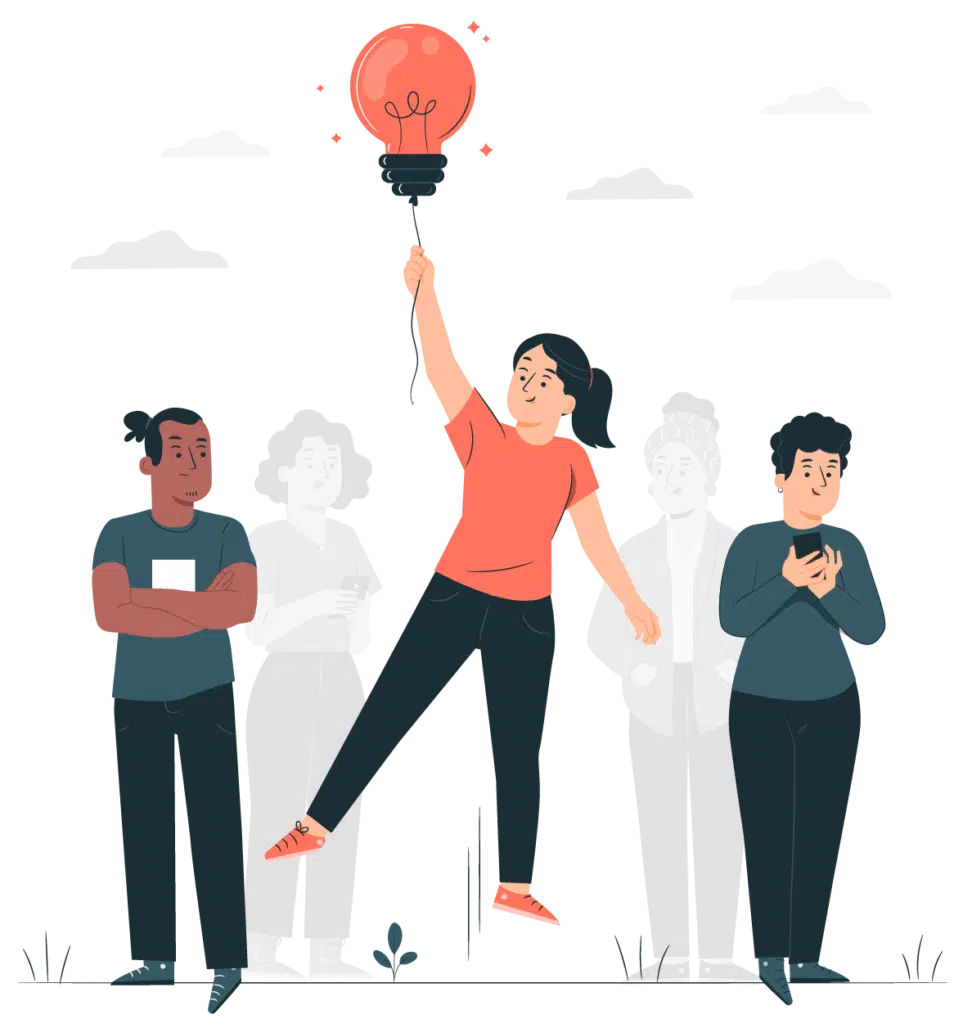
For Management/Organizations
One of the best uses of the GROW model is in corporate training.
All leaders are expected to know some goal-setting model that can motivate their teams to perform better.
There is no better model to achieve this than the GROW coaching model.
The structure allows the trainee to brainstorm and take the driver’s seat, while the trainer or leader gets the opportunity to see and reflect on the trainees’ needs and wants.
The flexibility of this model also allows trainees to work together and find solutions to common goals as a team.
Hence, it can also be used as a great team-building model.
In fact — when using this model with a group of two or more individuals, who work together and can have similar goals — it is best to work through the GROW model as a team, since it will help build affinity.
It will also help the team members understand each other’s thinking and attitude better.
For Individuals
I have already discussed at length how much the GROW model can help individuals.
The only thing I would like to emphasize here is that, as our tests have shown, this model is adaptable to a variety of situations, goals, and coaching styles.
It is not restrictive and can be used, as such, in any scenario.
Plus, it is a model that is best used for personal development.
For Teams
Apart from the corporate teams already mentioned above, this model can also be used for any other teams or groups; for example, during group coaching or marriage coaching.
You will just have to ensure that the group or team shares common goals that they want to achieve or resolve.
It can also be a good opportunity for the team to define their individual contribution and commitment to the common goal, and their responsibility towards achieving it.
The GROW model will also be a good resource to help people open free channels of communication.
For Parental/Teaching Coaches
Based on my first-hand experience, parental coaches or teaching coaches are best compared to corporate coaches, in the sense that they both excel much better if they have professional training under their belt.
Training especially helps when dealing with and understanding children. It can be difficult to get children to open up and talk about their feelings and problems with other people.
Hence, it is good to be familiar with the model.
Specifically with regards to the GROW model of coaching, it helps to broaden children’s thinking and set a more open approach toward problem-solving.
It also teaches children to be creative thinkers and problem solvers.
As with any other model and way of coaching, the GROW model also has its faults and drawbacks. Let’s delve into some of those.
Step 4:
Limitations of GROW Model
The GROW coaching model is not a ‘one solution fits all’ but much rather a solution that can be altered to provide multiple ways of resolving.
So while approaching the model and working with it, make sure to keep these few drawbacks in mind.

Critiques of the Model
Since the GROW model of coaching has been used for a few decades now, it is only natural that several great thinkers have suggested ways to make it better.
Through our practical knowledge, they have also addressed the question of how coaches can make it more effective in different scenarios.
Some of the critiques of the model are:
It’s Too Specific
The model is good for types of coaching where there is one ‘correct’ answer for every goal.
But it can fall short for career coaching or life coaching, where there isn’t one answer but rather many compelling choices.
In such a case, it would be unwise of the coach to steer their client in one direction; instead,let them explore which path they think suits them the best.
Plus, you will have to be ready to work with their client in case they fail to achieve the goal.
Our investigation demonstrated that, as the coach, you will have to motivate and be more sensitive to the client’s needs in such cases.
High Possibility Of Digression If A Topic Is Not Established
It has been suggested that the GROW model be called the T-GROW model.
The T in the model stands for Topic, which needs to be established before starting off with the GROW model.
The topic ensures that sessions do not digress too much; if they do, you are better-equipped to bring them back on track.
It’s Far Too Goal-Oriented
The GROW model can be extremely goal-focused and, unless you break down each goal into smaller tasks, it can make clients go around in circles.
Many coaches think that the GROW model needs to be used linearly. But that is far from the truth.
As a coach, you need to ensure that your clients keep reflecting back on the first two stages, while completing the last two stages, so that everything is better aligned and more concrete.
Many people spend too much time on the goal-formation stage of the GROW coaching model.
While setting and assessing goals is the fundamental stage of this model, if it becomes too time-consuming, the model can turn out to be counterproductive.
So here’s what I suggest — try to set timed sessions so that you can manage goal-setting much better with your client. This way, you also ensure that clients are not losing focus.
The model can also be too focused on behavioral changes, rather than changing or altering performance in the client’s life.
What is missing from the GROW model?
Everything might seem wonderful on paper, but humans are inherently lazy.
Our investigation demonstrated that, even after careful planning and consideration, when it comes to putting goals into action, most of us fail.
Let’s look at two important features—accountability and gratification—that, I think, are missing from the GROW model.
Accountability
It is so easy for people to wander off, find things that are much more important than personal growth, and concentrate too much on the hustle.
These are all just ways to avoid solving the problem at hand and delay results.
The best thing a coach can do, if a client is finding ways to avoid executing goals, is to have conversations focused on accountability.
Finding people in the client’s life who can keep them accountable is one solution. Or, if your clients are comfortable with it, you can team up with them to keep each other accountable.
The GROW model’s structure can really benefit clients if coaches keep them accountable for their goals and actions.
Gratification
Our findings show that another thing to consider while improving upon this model is finding ways to include gratification in the process.
We live in a world where gratification is cheap, easy, and instantly accessible. People have gotten accustomed to instant gratification, which hardly ever happens in life.
So when people do not get gratification, they can feel discouraged from continuing on their path.
We, as coaches, can work various ways of showing gratification into the GROW coaching model. These ways can be internal or external, depending on the client, as long as they feel a sense of achievement.
Appreciation can be built into sessions, but I also suggest freely complimenting clients on a positive step executed in the GROW model.
Things to Consider
As I have mentioned before, the GROW model is not a ‘one solution fits all’ model; nor is it a replacement for other long-form coaching methods.
I cannot stress this enough — coaches should look at this model as complementary to other methods they already employ.
You cannot treat each client in the same way, and spend the same amount of time on each phase with every client.
Sometimes, a client might need more time in the Goal-setting phase, but might breeze through the Options phase.
Other times, a client might take less than half a session to determine the goal but might take a very long time in the Options or Reality phase.
So you, as a coach, have to mold your sessions and training according to each client.
Step 5:
Case Studies
There are multiple people and institutes that use the GROW coaching model, but due to many restrictions and NDAs, it can get tricky to share details and case studies.
However, I am mentioning some of the best-known universities that use the GROW model for coaching in their classes, as well as to train their faculty and staff.

New York University (NYU), USA
One of the most famous universities in the world, NYU, uses this method of coaching for leadership and also when it employs international coaches for students and faculty.
Our research indicates that, although they do not speak about this frequently, they use this model to bring out the best leadership qualities in their staff.
Imperial College of London
Another prestigious institute, Imperial College of London, also employs and teaches this method to their students in leadership courses.
Students are initially given tasks to work through the GROW coaching method by themselves, then in a group, and then to consult other people about their goals.
They spend a substantial amount of time in their leadership-based curriculum encouraging students to understand and implement this method.
Conclusion
I would like to congratulate you for going through the entire guide!
It is a lot of information to process and I hope you have derived value from it, and gotten an in-depth understanding of the GROW coaching model.
As we part, I would like to remind you of the most important aspects of this method:
- The GROW coaching model is versatile yet non-linear. It can be used with any type of client for any type of coaching.
- It has four phases: Goal setting, Reality assessment, Option exploration, and Way forward to achieve the goals.
- I have provided you with guided questions that are sure to set your client on the right track using this model.
- The GROW coaching model has its limitations, but you can overcome them by keeping your client accountable and appreciating their efforts.
- This coaching model is not a replacement to your existing methods of coaching, but rather a complement to them.
Do you have any questions that I have left unanswered?
Let me know in the comments section, and I’ll make sure I address all your queries.
Frequently Asked Questions
1. What does each step in the GROW model represent?
The GROW model is an acronym for Goal, Reality, Options, and Way Forward. The Goal step involves identifying and clarifying the desired outcome or objective. Reality focuses on understanding the current situation, including strengths, challenges, and resources. Options involve brainstorming and exploring various strategies and possibilities to achieve the goal. Finally, the Way Forward step involves creating a concrete action plan and determining specific steps to move toward the goal.
2. How can the GROW model help individuals overcome obstacles and achieve their goals?
The GROW model provides a structured framework for individuals to assess their current reality, explore different options, and create a plan of action. By breaking down the goal-setting process into manageable steps, the model helps individuals identify and address obstacles, develop strategies, and maintain motivation. Through self-reflection and accountability, individuals can make progress, overcome challenges, and achieve their desired outcomes.
3. Can the GROW model be used in group coaching or team settings?
Yes, the GROW model can be adapted for group coaching or team settings. In such contexts, the model can be applied collectively to set shared goals, assess the team’s current reality, brainstorm options collaboratively, and determine the way forward as a group. The GROW model promotes open communication, active listening, and collective problem-solving, enabling teams to work together towards common objectives.
4. How can coaches effectively use the GROW model in coaching sessions?
Coaches can effectively use the GROW model by asking open-ended questions, actively listening, and providing guidance throughout the coaching process. They help coachees clarify their goals, explore their current reality objectively, generate options, and establish an actionable plan. Coaches also support coachees in maintaining focus, tracking progress, and celebrating achievements. The GROW model serves as a guide for coaches to facilitate meaningful conversations and empower coachees to take ownership of their growth and development.

Download a FREE PDF version of this guide…
PDF version contains all of the content and resources found in the above guide.



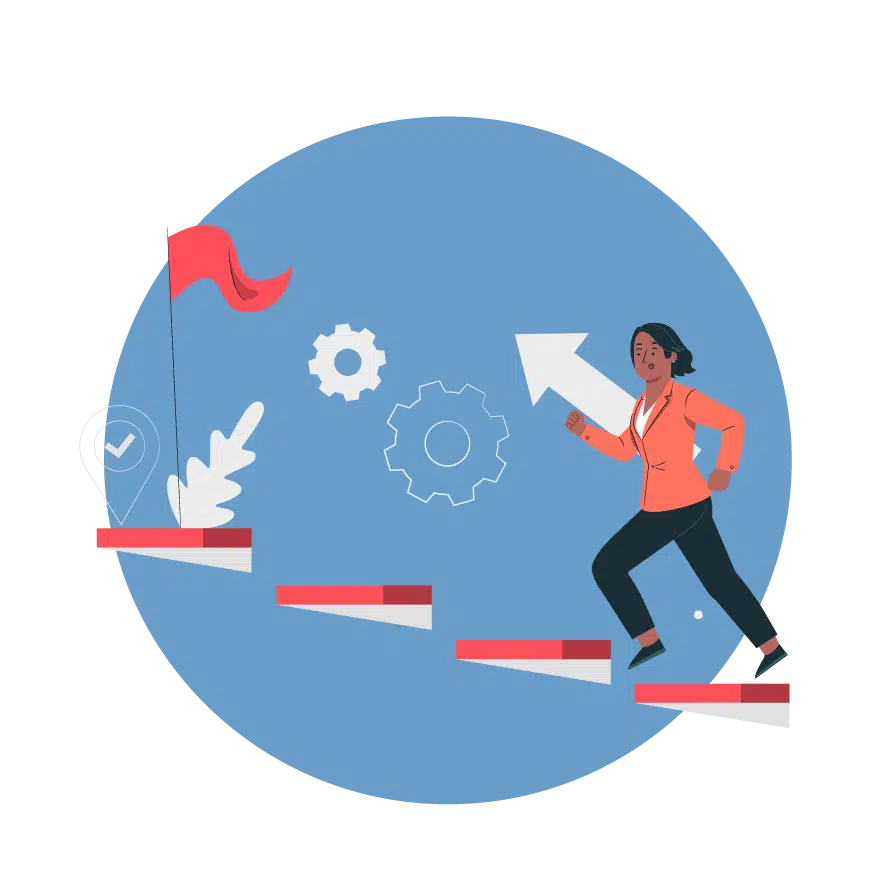
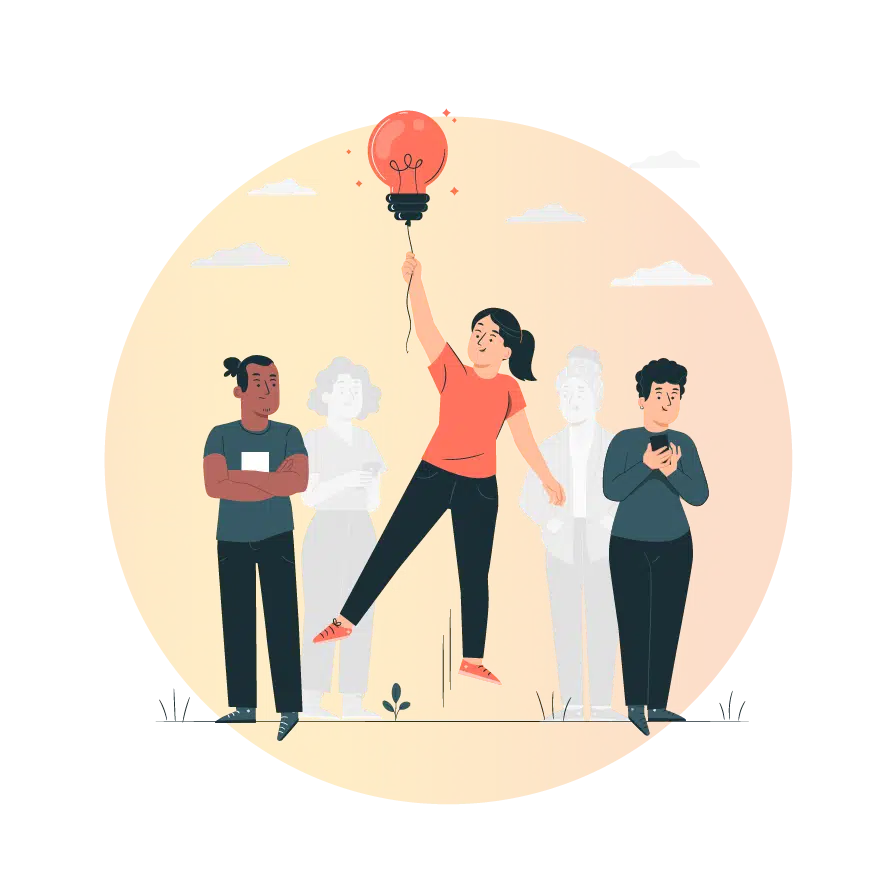




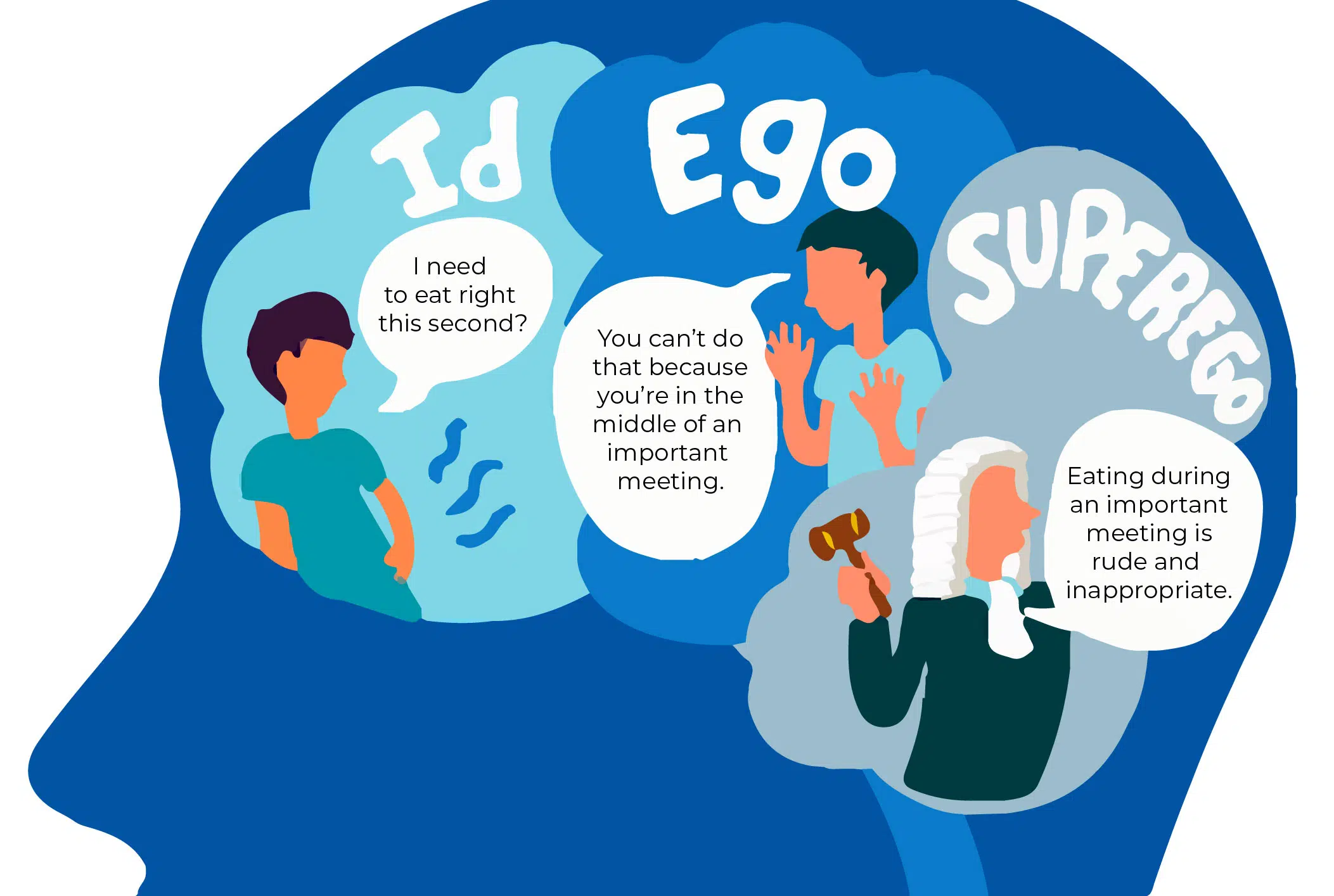

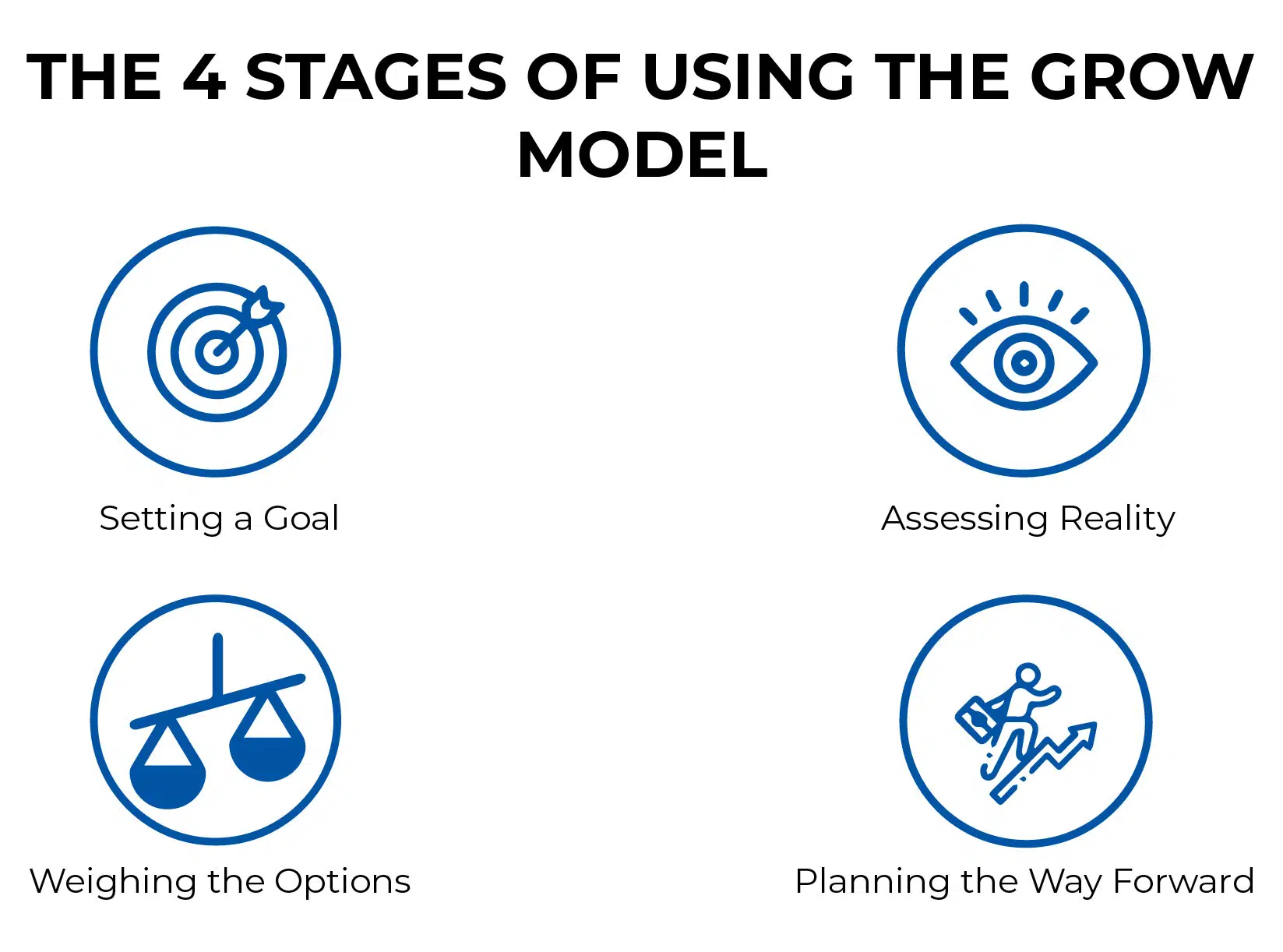
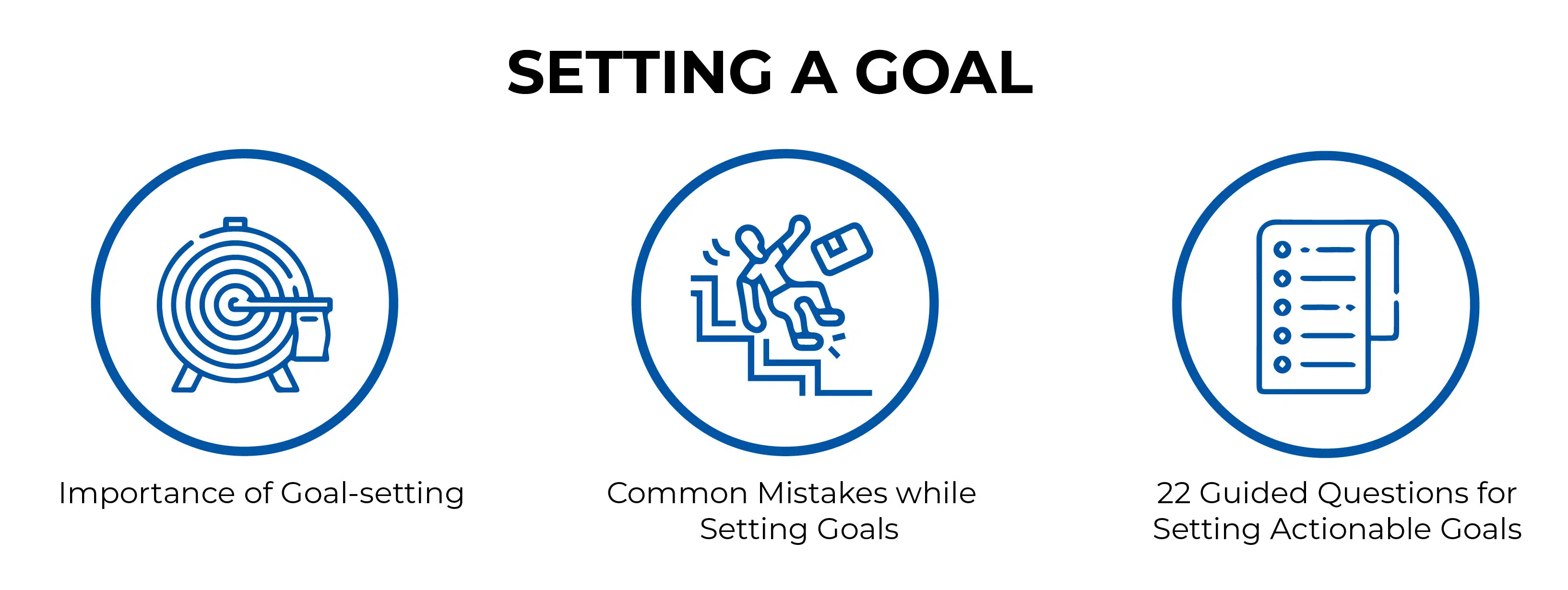


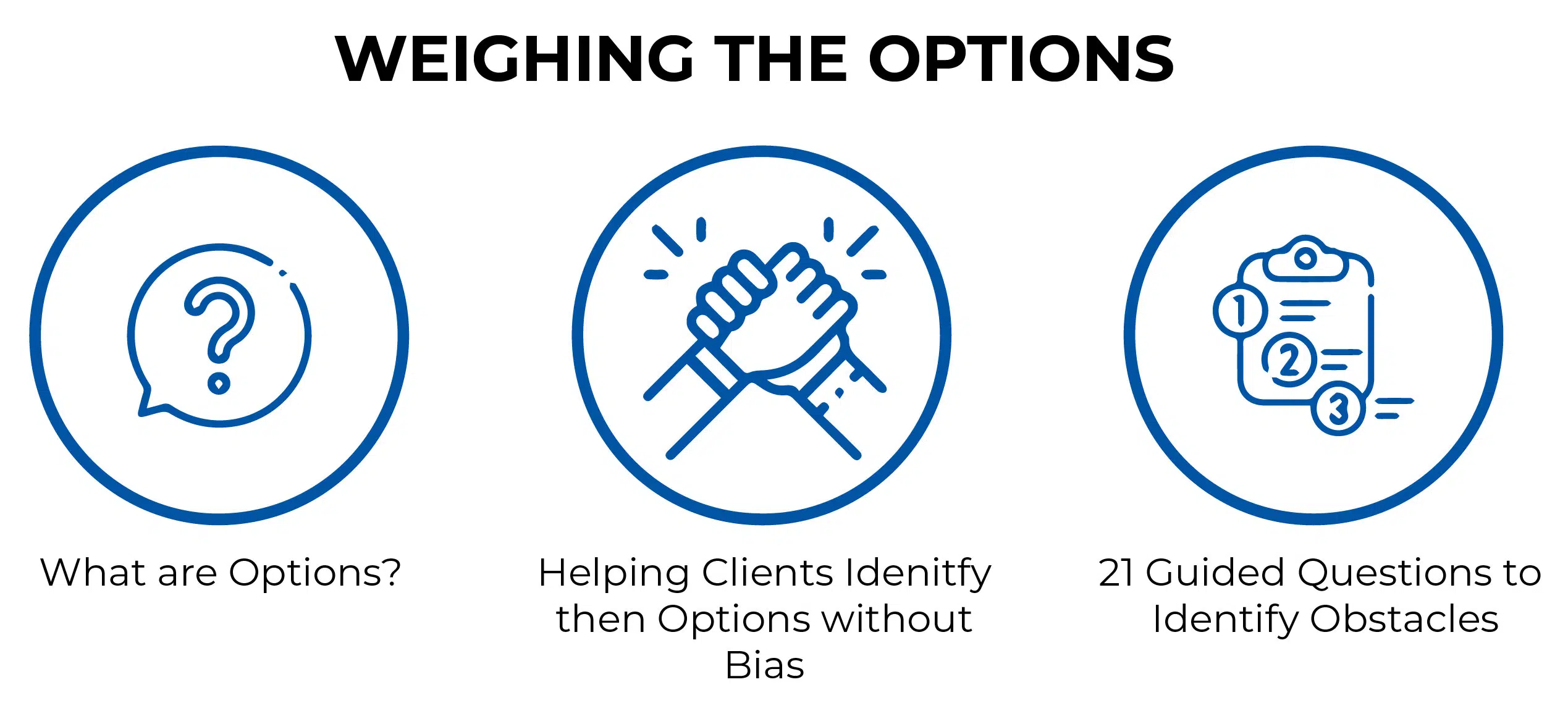


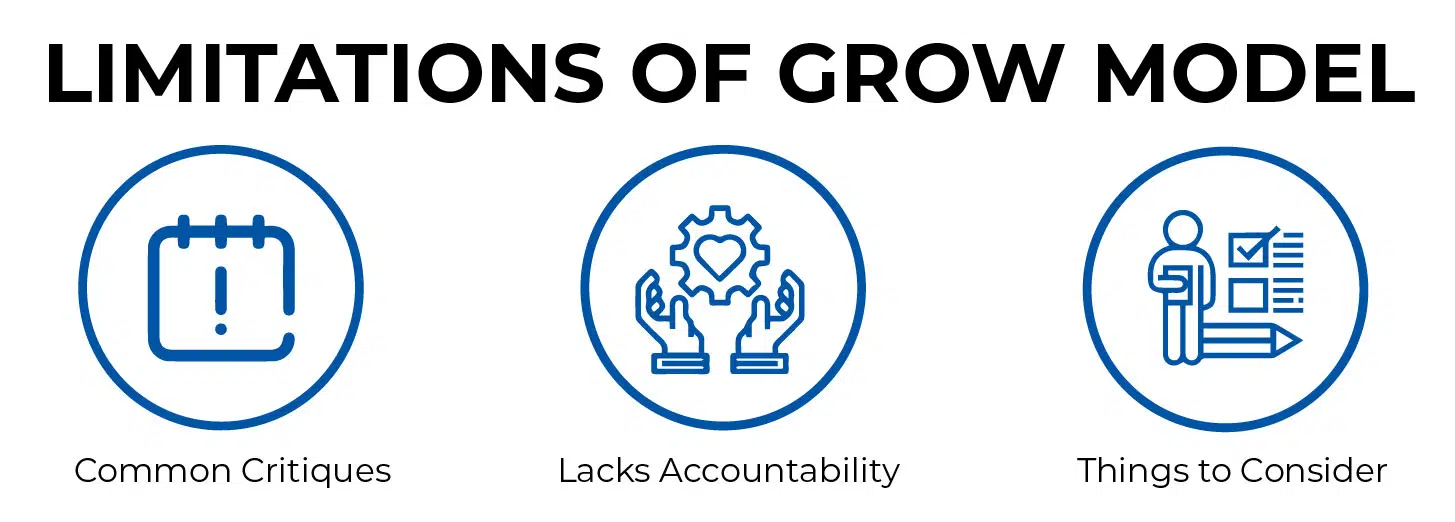






Coaching modes are very helpful in any field whether it is academics, preparing for a quiz competition, or in the workplace. Everywhere smartness and effective work is valued rather than tiresome and inefficient work. As beautifully explained, coaching models help in the improvement of overall performance. Tha k you for this guide.
I was curious about the GROW model and its benefits, so thought of researching this passionate topic. I loved the way the topic was described here and its other subtopics. A very helpful guide for new beginners like me.
I heard about the GROW model for the first time from my rude boss. I was inquisitive about the topic and wanted to read about this as well. I had been to other coaching models like OCEAN and STEPPA and was delighted to read the complete article.
I love the way how GROW coaching model is described here. It’s purpose, benefits, and how to use it effectively daily. All my previous doubts have been resolved regarding the model and it was effectively illustrated with good graphics and examples.
The article was written in the utmost simple form and well structured. It briefly elucidated the GROW model and its benefits. Also, explained about it’s each, 4 stages of using the GROW model.
I loved the way the article is written. It is a self-explanatory guide on how to reach your clients in uncovering obstacles, outlining objectives and outcomes for a problem. Also, narrated how the model can complement one’s regular practice.
GROW stands for Goals that one desires to accomplish. Reality that one needs to analyze and comprehend to formulate a conscious judgment. Options, and the impediments that one needs to contemplate while making that judgment and Will (or way forward) to make the proposal pan out in reality. The article is very well structured.
This guide on the GROW model has briefly explained its benefits, types, examples, and justifications on how to use the model. I liked its quality content and the flow. Initially, it stated what GROW model is all about and later touched on complex terms like its benefits and uses.
There is an increase in my client leads because of practicing GROW models on them. I use this model to tell my clients to think of it as being similar to scheduling an excursion. To begin with this, they will expect to deduce where they want to go (i.e. the goal) and later other steps to successfully come to a better conclusion.
One of the best things about the GROW model is that the GROW model can be utilized at any stage of coaching, and even at numerous stages with many goals or purposes. I learned this from an article which has saved me a lot of time.
There are several example questions of GROW models in the article which has influenced my mindset and given me a new motivation to complete my daily tasks.
I have become more chatty with my clients which was a primary reason that I wasn’t able to guide them effectively. Setting a proper goal has helped me bring them back to the topic and prevent digressions which have led to better solving of the client’s problems.
I am a normal employee and worked all day to impress my body and get a promotion soon but there was always some other reason that my abilities were lacking. I am grateful to this guide for helping me tackle this problem effectively.
It was troublesome before reading the article for me to discover an appropriate niche for my business. It lacked proper goal setting. After going through the article, I worked upon my weaknesses and modified my current practices.
In a classroom setting too, the GROW model is very helpful as shown in the article. Both the students and the teachers can adopt the GROW model to take benefit of it and lead a directed life. Thank you for publishing this article.
Your posts are always well-written and easy to understand.